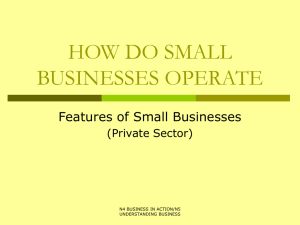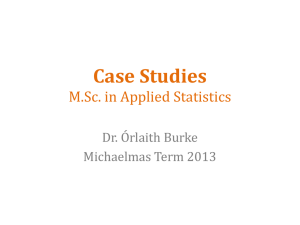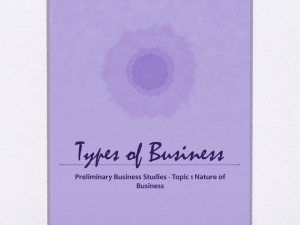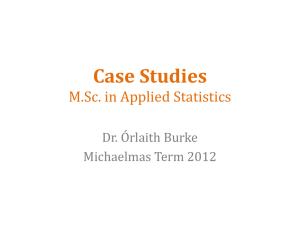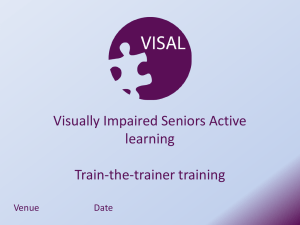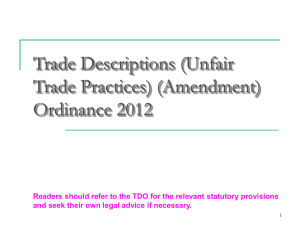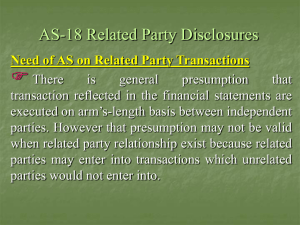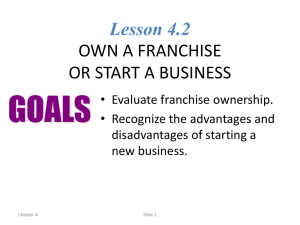Understanding Business Outcome 1
advertisement
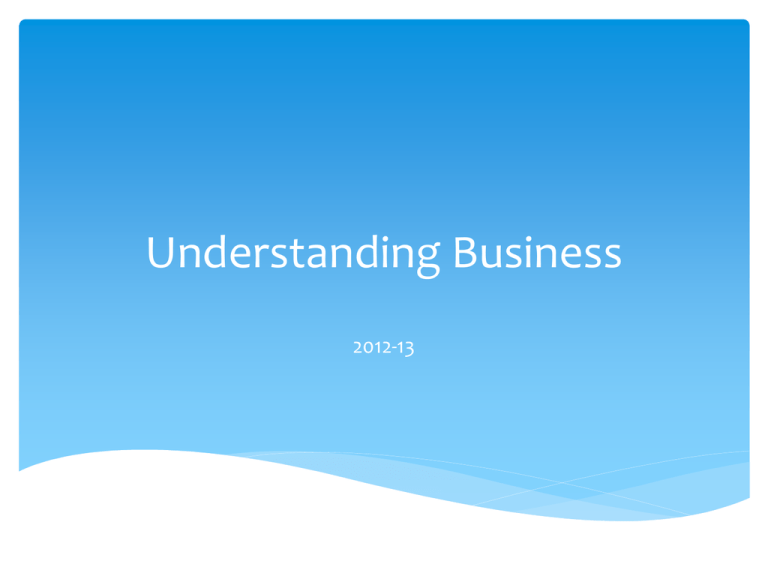
Understanding Business 2012-13 Contents Needs/Wants & Goods/Services Risks Factors of Production Entrepreneurs Sectors of Industry Sectors of Economy Business Plan Sources of Finance Business Aims Private Sector Orgs Public Sector Orgs Third Sector Orgs Write down something that you really really want. 3 Needs and Wants Clip Clip2 A need is anything essential we must have to stay alive. We need food, drink, clothing and shelter. A want is anything not so essential but something we would still like to have. We want a television, a foreign holiday or designer clothes. 4 Task Show the difference between needs and wants. You can do this using a PowerPoint, poster or a comic strip. Software: Microsoft PowerPoint Comic Life Microsoft Word Microsoft Publisher 5 Why do businesses exist? 6 Businesses exist to satisfy our needs and wants. They provide: 7 Goods and Services A good (product) is something made by a business that you can touch or see. Examples - a car, a football, a pair of boots. A service is something you cannot hold or touch. Often a service allows one person to use skills they have to help others. Examples - haircut, life insurance, cinema attendant. 8 Task We will now see slides of various businesses. Do they provide a product or a service or both? PowerPoint 9 Opportunity Cost When something is Scarce and we can’t have everything we want, we have to make CHOICES. For example: which TV programmes will I watch tonight? which pair of jeans will I buy? which courses will I choose to study? When we make a CHOICE, this means that we decide to give up something in order to get something else. We choose the option that will give us the most pleasure and satisfaction. The cost of choosing something is the things that we gave up to get it. This is known as OPPORTUNITY COST. Why Start A Business? You might start off with very big ideas Only 50% of new businesses starting up survive after 3 years. Given the risk, why would people want to start up a business in the first place? Independence – Own Boss Made Redundant – Redundancy Money To Invest You Keep All Profits Your Firm = Your Deadlines You Have A Good Idea – Can’t Persuade Others Difficulty Finding Employment Innocent Drinks The story of the Innocent drinks company - the highs and lows for the founders. It shows the motives behind founding the company, the excitement of start-up, and the integrated nature of the process. The financial aspects are also briefly covered. http://www.bbc.co.uk/learningzone/clips/financial-aspects-of-businessstart-up/8490.html Being Your Own Boss The big advantage of starting your own business is that you get to order everyone else around – and decide what to so with all the profits. But there are problems: Problem One The business may take time to produce a profit – the owner’s income may be small and vary from week to week. Problem Two There is no-one else to take the blame if anything goes wrong – the owner must be prepared to take responsibility. Problem Three Owners of new firms generally work very long hours – for example, completing the firm’s accounts in the evening. Problem Four As the business grows the owner needs to learn to delegate responsibility to subordinates – not easy if the owner has built the firm up single-handed. Factors of Production Land – natural resources eg water, trees, fruit, fish Labour – human workers – mental and physical effort Capital – money, buildings and machinery Enterprise – the development of ideas and drive for implementation Job Description Details about the job including: job title, main duties and responsibilities, working conditions Person Specification Qualities and skills expected of potential candidates – usually split into essential and desirable Entrepreneurs What is an Entrepreneur An entrepreneur is an individual who develops a business idea and takes on the associated risks and responsibilities. Qualities of an Entrepreneur Calculated risk taker Competitive Confident Creative/inventive Determined Good communication Hard working Patient People skills (respect) Planning/organisation Positive attitude Spot problems Willing to learn Entrepreneur Case Study Watch the clip on SuperJam Write down relevant information about becoming an entrepreneur. Task – From the website below pick one other company of your choice and write down information relevant to becoming an entrepreneur. www.tinyurl.com/entrepreneurvideos Types of Business Sectors of Industry Primary Organisations involved in the extraction of the earth’s natural resources Secondary Organisations involved in the manufacturing of raw materials to be turned in to finished goods Tertiary Organisations involved in the selling of goods and providing services. Sectors of Economy PRIVATE SECTOR Owned and run by private individuals/groups Sole Trader, Partnership, Private Limited Company (Ltd), Public Limited Company (Plc), Franchise PUBLIC SECTOR Owned by the taxpayer and run by the Government NHS, Education, Police, local councils services THIRD SECTOR Owned and run by private individuals with the purpose of helping a group or raising awareness for a cause. Charities, Non-profit making organisations Types of Business Organisation In the previous slide we have looked at sectors of the economy: Private Public Voluntary If you were to start your own business it would be in the private sector and it would be called a Sole Trader Sole Trader A sole trader is the most common type of business. It is owned, controlled and financed by one person. Examples of sole traders are: Plumber Electrician Mechanic Hairdresser However, anyone can start up their own business doing whatever they want. Sole Trader In pairs write down as many advantages and disadvantages of being a sole trader that you can think of – 3 minutes Advantages Make your own decisions Profits are not shared No special paperwork required Disadvantages Long Hours Hard to raise finance Unlimited Liability for debt Hard to cover illness/holidays Planning Your Business ** The Business Plan ** Ideas for a New Business You have decided that you would like to start your own business and become a sole trader. In order to begin any business you must make a Business Plan laying out your business aims. First you must decide what business you would like to set up. Decide on 3 businesses you would like to start? Make a list of the pros and cons for each business? Choose a business and briefly detail what this business will do. Task 1 …some ideas are on the next slide…. Possible Ideas? Can you think of some better ones? Refreshment stand at local sports events Child care Shopping service for seniors Pet sitting Delivery services House cleaning service Selling used clothes Jewellery making Travel services Musical group Computer support: setting up computers/internet connections for others You might even… add value to an existing product (packaging, new Marketing local crafts design, new customers, different size) Task 1 Billy’s Business Plan It’s great having the ideas… but you must be prepared for the hard-work and dedication taking your business forwards. More than the idea Barclays Business Lounge It’s great having the ideas… but you must be prepared for the hard-work and dedication taking your business forwards. Business Lounge Video What is a Business Plan? The business plan is a tool designed to help you find and explore opportunities. It also provides you with a way to analyse potential opportunities continuously. A business plan is personal and should never be prepared professionally by others. No one knows you or your ideas better than you do. It is the process of seeking the answers to important questions about your enterprise that are important as you try to realise the dream of owning your own business. Time for research Preparation is essential Working within the time available, complete the template document which will get you thinking about your business. You may not have all the answers at the moment, but be as detailed as you can be… Next week you will start to write your business plan, before presenting your idea in Lesson 3/4. Task 2 and 3 Writing the Business Plan Convince others… Using the Guideline Document, create your business plan. You will submit this business plan for marking by ‘The Bank Manager’ Use a fresh document and your IT skills to prepare a professional and informative document. Task 4 The ‘Elevator’ Pitch Be straight to the point! What are the key factors about your business? What do people need to know? Watch the Video… Prepare Your Pitch – Task 5 Business Aims and Objectives Why do businesses have aims? What aims might they have? How do they communicate these aims? Business Aims and Objectives What is an aim? An aim is where the business wants to go in the future, its goals. It is a statement of purpose, e.g. we want to grow the business into Europe. What is an objective? Business objectives are the stated, measurable targets of how to achieve business aims. For instance, we want to achieve sales of £10 million in European markets in 2014. Why have aims? BRIEF Task: Why do you think businesses have aims… discuss with a partner and write down as many reasons as you can in 2 minutes. Why have aims? Suggested Answers: Separate your company from others – make it stand out Indicate the direction the company is heading in Might use aims as part of a slogan Customer service Quality Customer support What employees should believe Why have aims? Aims are often directed at: Customers Competition As you work through this unit… think who different companies aims and objectives are directed at… Employees Possible Aims BRIEF Task: What aims might a company have… again 2 minutes to discuss and come up with as many ideas as possible Possible Aims Provide a High Quality Service Growth Survival Suggested Answers: Increase Market Share Eliminate Competition Did you have any others? Be Socially Responsible Value for Money Increase Profitability Do Aims and Objectives Change? YES! Over time due to internal and external pressures… more about this later. Communication of Aims? BRIEF Task: How do businesses communicate their aims?… discuss with a partner and write down as many reasons as you can in 2 minutes. Communication of Aims? Suggested Answers: Business Plans Company Handbook Company Website Company Letterheads/Brochures Annual Report Adverts (newspapers, TV etc) and in its Mission Statement… Mission Statement A mission statement is a statement that defines the purpose of a company – what it stands for i.e. what broad products or services it intends to offer customers. The mission statement also gives readers a window on the raison d’être (the main purpose) of the company. An effective mission statement should be concise enough for you to describe your company’s purpose and ideals in less than 30 seconds. Where would I see a Mission Statement? Mission Statements typically appear in business plans or alternatively will appear in the ‘Corporate Relations’ or ‘About us’ sections of websites. Mission Statement Guidelines A mission statement should say who your company is, what you do, what you stand for and why you do it. The best mission statements tend to be 3-4 sentences long. Avoid saying how great you are, what great quality and what great service you provide. Make sure you actually believe in your mission statement, if you don’t, it’s a lie, and your customers will soon realise it. Aims/Objectives Task Find out more about mission statements by carrying out the ‘Mission Statement’ task on the server. Using the template provided research the aims/mission statements of organisations in the private, public and third sector eg Coca-Cola, the BBC, and Haddington Camera Club Homework: write a mission statement for your business (remember your business idea before Christmas) Solutions to Extension Task Coca-Cola Our mission is: To refresh the world - in mind, body and spirit To inspire moments of optimism - through our brands and actions To create value and make a difference everywhere we engage BBC To enrich people's lives with programmes and services that inform, educate and entertain. Haddington Camera Club aims to provide a friendly and supportive forum for everybody interested in photography, whether they are beginners, experienced photographers, or somewhere in between.Club Sources of Finance What sources of finance are available to businesses? What advantages and disadvantages does each have? Short-Term Finance Bank Overdraft Taking out more money from a bank account than is deposited in it Trade Credit Paying for goods from a supplier at a later date (eg 30 days) Factoring Selling invoices to another company to collect the money Grant One-off payment often from government or the Prince's Trust – does not need to be repaid. Retained Profits Profits kept back from previous years Medium-Term Finance Bank Loan Money lent for a specific time period – paid back with interest Leasing Renting – often vehicles or equipment Hire Purchase The purchase price is paid in instalments Long-Term Finance Owner’s Savings “the owner’s savings” Share Issue A part-ownership in a Ltd or plc (a share) Mortgage Loan secured on property Debentures Source of finance used by plcs Venture Capital Think Dragon’s Den – often used for risky ventures Haddington Conservation Area Regeneration HCARS is a grant programme supported by East Lothian Council and Historic Scotland that makes available funds for regenerating and improving Haddington Town Centre through repairing and enhancing the historic fabric. The Haddington CARS is an action point in East Lothian Council’s Haddington Town Centre Strategy 2009-2014. The grant is available for good quality, long lasting repair and enhancement work on projects that are located within the CARS Area. The scheme funds enhancements and repairs to shop fronts (repainting, signage), small repairs to buildings (sash and case window refurbishment, gutters and downpipes) as well as comprehensive tenement repairs (masonry repairs, roofing etc.). Choosing a Method of Finance If you are asked in a question to give sources of finance for a specific type of business make sure that your answers are relevant eg if asked for a source of finance for a sole trader to expand, debentures would be inappropriate to include in your answer. Finance Task No. 1 Let’s find out about the advantages and disadvantages of each source of finance. You will be provided with an envelope containing a number of cards. Match each source of finance with its advantage and disadvantage. Finance Task No. 2 In groups of 3… Using the completed answer sheet (from Task 1) prepare 3 A4 sheets illustrating the advantages and disadvantages of short, medium and long-term sources of finance. Finance Task No. 3 Real life? Using the template provided carry out some research into the difference sources of finance available today. Re-cap… There are 3 Sectors of Economy that exist, they are called… Private Public Third (Voluntary) We have looked at one type of Business in the Private Sector already, it is called… Sole Trader Types of Business Organisation (PRIVATE SECTOR) We are now going to look at other organisations that exist in the :PRIVATE SECTOR Partnerships Private Limited Companies (Ltd) Franchises (small) Partnerships A partnership owned, controlled and financed by 2 – 20 people (partners). Partnerships are usually found in professional practices, for example: Doctors Lawyers Vets Partnership In pairs write down as many advantages and disadvantages of being a partnership that you can think of – 2 minutes Advantages Can raise more capital (from partners) Risks and responsibilities are shared Can keep activities private Disadvantages Unlimited liability Formal paperwork required Disagreements amongst partners Liability Unlimited Liability Limited Liability The owner(s) must pay off all debts of the business. This may result in them losing personal possessions. The owner(s) are only liable for the debts of the company up to what they have invested. They can only lose their investment. Sole Trader Partnership Ltd PLC Private Limited Companies (Ltd) A Private Limited Company is owned by shareholders, controlled by a board of directors and financed through selling shares. Shares are bought and sold privately, they cannot be sold on the stock market. Examples of Private Limited Companies are: Eddie Stobart Ltd Phones 4U Ltd Walkers Snack Foods Ltd Private Limited Companies In pairs write down as many advantages and disadvantages of being a Ltd that you can think of – 2 minutes Advantages Raise more capital through selling shares Shareholders have limited liability Likely to employ specialists Bigger firm? Disadvantages Accounts are not kept private More complex and expensive to set up Have to share profits – DIVIDENDS Shares can’t be sold on the Stock Market Franchise (small) This is where a new business trades on an already established successful businesses name. The new business pays for permission to use the existing name. The business is owned and financed by the franchisee. It is controlled by both the franchisee and franchisor. Examples of small franchises are: Baguette Express Video – Festival Franchise Franchise (small) In pairs write down as many advantages and disadvantages of being a franchise that you can think of – 2 minutes Advantages Already established recognisable name Guaranteed customers Cost less to set up Given help setting up Less chance of failure Disadvantages Have to give a % of profit to the franchisor Has to be run according to the rules set out by the franchisor Hard to introduce own ideas and methods Private Sector – Summary! The private sector consists of different types of businesses owned by private individuals: Sole Trader Partnership Private Limited Company (LTD) Public Limited Company (PLC) Franchise PUBLIC SECTOR The public sector is owned by the taxpayer (the state), it is financed through collection of taxes, and it is controlled by the government. Examples of Public Sector organisations are: NHS Schools Police Local Councils BBC Public Sector Watch the clip on how the public sector is financed and answer the following questions? Name 4 types of tax the government collects? Name 4 services the government spends its money on? How much does the government collect a year? How much does the government spend a year? What does the government have to do with the spending gap? Public Sector Aims The public sector has very different aims compared to the private sector, it does not aim to make a profit. It aims to: Provide a quality service to everyone within a certain area. Make good use of the taxpayers money, by providing relevant services. Stay within a budget. Task You have been given the job of BBC One Programme Coordinator, and must decide on one days programming. You have been given a list of programmes to choose from to fill the day between 0900hrs and 0000hrs. You must: Choose a wide variety of programmes to meet the needs of all viewers Ensure that you stay within your budget of £100,000 THIRD SECTOR (Voluntary) The third sector looks to benefit communities and help people less fortunate. Organisations in this sector are owned and controlled by private individuals. They are financed through selling goods, providing services and collecting donations. Three types of Third Sector organisations are: Charities (Oxfam) Non-Profit Making Organisations (Sports Clubs) Social Enterprises (The Big Issue) *see later* Third Sector Aims Third Sector organisations aim to: Provide support for worthy causes (British Cross) Raise awareness of an issue (WWF) Provide the best service and facilities (Sports Clubs) Re-invest profits to further a cause (Eden Project) Social Enterprise A social enterprise is a business that trades for a social and/or environmental purpose. It will bring in most or all of its income through selling goods or services. It will have clear rules about what it does with its profits, reinvesting these to further the ‘social mission’ Examples of Social Enterprises are: The Big Issue The Eden Project Jamie Oliver’s ‘Fifteen’ Social Enterprise In pairs write down as many advantages and disadvantages of being a social enterprise that you can think of – 2 minutes Advantages Use local skills and life experience Improve on a ‘social mission’ Target specific sectors of the community Disadvantages Need specific skills, knowledge and expertise Must meet their social aims Investigation Choosing one of the Third Sector organisations prepare a brief report to be fed back to the class that includes: The organisations mission statement. (5mins) How do they achieve their goals (5mins) Facts and figures about the organisation. (5mins) 10 mins to collate information Feedback to class
